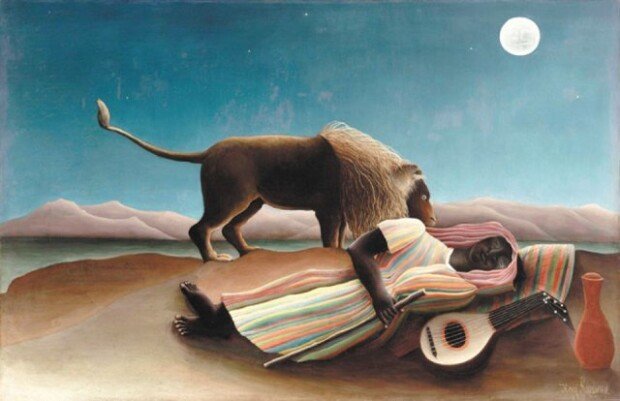Sleeping Beauty and the Beast
Sleeping Beauty and the Beast
Posted September. 16, 2021 07:32,
Updated September. 16, 2021 07:32

A woman lies in the desert, sound asleep against a full moon. She holds a stick in her hand, and there is a mandolin and vase made of clay nearby. A big lion comes near and sniffs the woman, creating tension. Would the woman be safe?
This massive painting, which is more than 2 meters wide, is one of Henri Rousseau’s most famous paintings. Rousseau, who had worked as a customs officer in Paris for 22 years, retired at the age of 49 and became a full-time painter. He started to paint at 40 and regularly exhibited at Salon des Indépendants, but people made fun of him by calling him Duanier (customs officer) or Sunday painter.
He had not been professionally trained as a painter, so his use of color, perspective and depiction of proportion was relatively unskilled. However, Rousseau believed in himself. Though he was not as adapt at painting objects realistically, the painter was confident in using his imagination to add uniqueness. He had not travelled to exotic places, but he was adept at depicting exotic themes. The exotic plants and animals he had seen at the Paris Jardin des Plantes and the Universal Exhibition became his models. This painting, which he painted at 53, was probably created by his careful and thorough observation of the lion, musical instrument, and the clothing of the woman. Due to the lion, who is depicted as friendly, and the skin color of the woman, the painting is often likened to France’s colonization of Africa, imperialism masked as a protector and pacifist.
What as the intention of the artist in creating the painting? According to Rousseau, the woman in the painting is a tramp mandolin performer who is tired and sound asleep. A lion passing by caught her scent, but he does not harm her. The soft moonlight transforms tension between the lion and the woman as peaceful and magical. Perhaps the artist’s message is to say that even hungry beasts do not tempt those in sleep, in other words, protecting the weak.
Headline News
- N. Korea launches cyberattacks on S. Korea's defense companies
- Major university hospital professors consider a day off each week
- Italy suffers from fiscal deficits from ‘Super Bonus’ scheme
- Inter Milan secures 20th Serie A title, surpassing AC Milan
- Ruling and opposition prioritize spending amid tax revenue shortfalls







